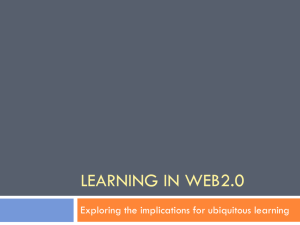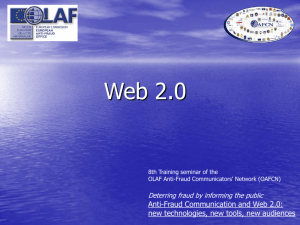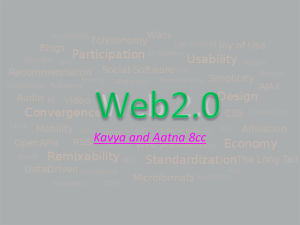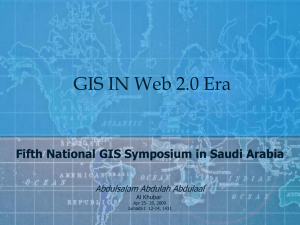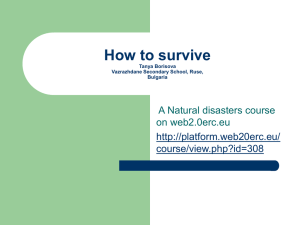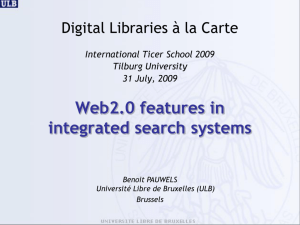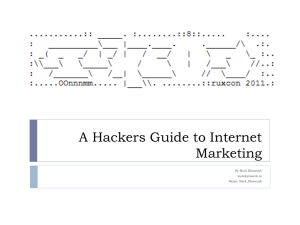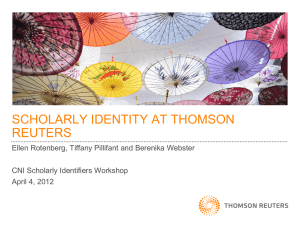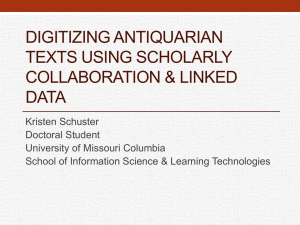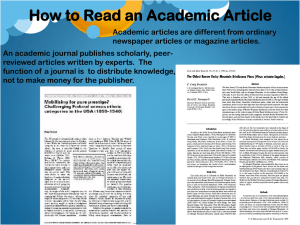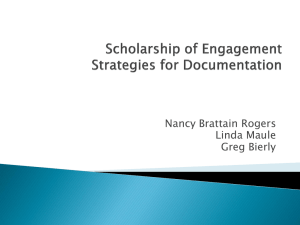Researching Web2.0 and Scholarly Communication
advertisement
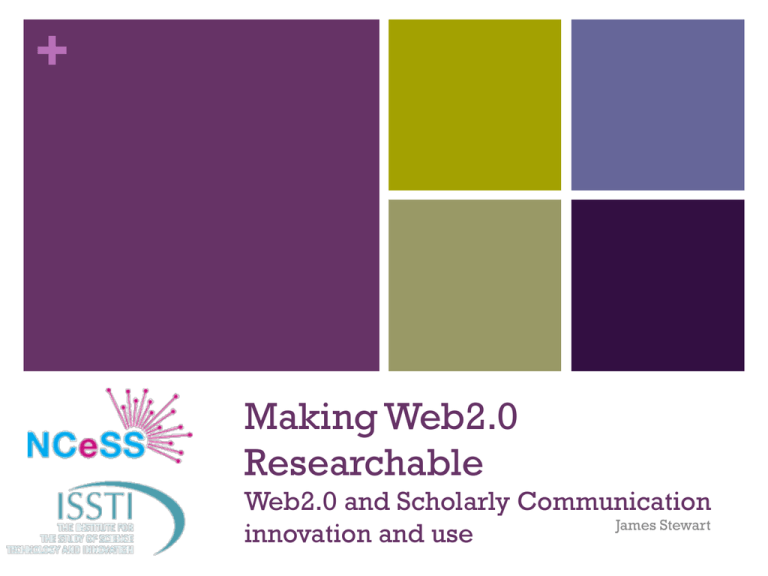
+ Making Web2.0 Researchable Web2.0 and Scholarly Communication James Stewart innovation and use + + Scholarly Communication Conducting research, developing ideas and informal communications. Preparing, shaping and communicating what will become formal research results. The dissemination of formal products. Managing personal careers, and research teams and research programmes Teaching and communicating scholarly ideas to broader communities.(based on Thorin (2003) ) + What is Web2.0? + Characterised by example Technical and content forms E.g. blog, wiki, social networking tool, social bookmarking, peer to peer filesharing, etc Particular Branded Service or Resource Facebook Skype OpenWetWare Sharepoint Wikipedia + Web2.0 Way of describing certain postdot.com bust businesses Technological definition: “Web 2.0 encompasses a variety of different meanings that include an increased emphasis on usergenerated content, data and content sharing and collaborative effort, together with the use of various kinds of social software, new ways of interacting with web-based applications, and the use of the web as a platform for generating, re-purposing and consuming content.’ (Anderson 2007) The way technology is being driven by individuals and communities seeking to manage the explosion of information, and the move to ‘networked society’ + “Qualities of Web2.0” “Openness” “Usability” “Light structures” “User creation and contribution” “Massive data” “Power of the ‘crowd’” “Network effects” Problem: None unique to Web2.0 + How to describe a Web2.0 … Tool System Service Community Organisation Collection etc + Approaches to Web2.0 Technology Business model Organisational approach Individual and social practices – for information use and interactions Structure of knowledge Expectations + Academic archaeology Many of communicative and information practices characteristic of Web2.0 are characteristic of scholarly communication. However, some Many Many of these forms are rather ossified! earlier internet tools used in Web2.0 way more well established trajectories of sociotechnical change. What does Web2.0 add? + e.g. Collaboratories Shared instruments Community Data Systems Issues of: Tacit knowledge Open Community Contribution Systems Independence of scholars Virtual Community of Practice Information Standards Virtual Learning Community Distributed Research Centre Institutional and national barriers Community Infrastructure project Sustainability Bos et al. (2007) + Working model services for discovering and maintaining relationships services for sharing research objects and components services for sharing, annotating and commentating on publications and presentations services for documenting and sharing experiences. + How do you use ‘Web2.0’? How might you define it? Is it useful or distracting? Is the idea of qualities useable? Does Internet =Web2.0 now? + Framework: Social Shaping of Technology Technologies emerge from complex processes of invention, implementation, failure and success Many different social and technical players and objects effect outcome Sources of innovation included user communities as well as producer groups Non-linear process involving changes in practices, knowledge, structures and relationships + Framework: Social Learning in Innovation Changing relationships between players in innovation as they interact and learn in the processes of invention and implementation. Importance of visions and theory in promoting and aligning expectations Importance of intermediaries in bringing together innovations from different communities Emergence of new intermediaries + Factors shaping Web2.0 in SC Ownership and control of scholarly products, both by scholars and institutions such as universities and publishers Institutional, individual shaping collaboration and cultural factors Technical implantation of support for Standardisation, IPR and security Epistemological issues arising in creating and implementing computer-based communication tools. + Principal issues governing the Dynamics of socio-technical change Disciplinary differences Scholarly knowledge production Structure, economics, maturity Institutional and culture. differences Non-academic influences – individual and broader social appropriation of Web2.0 practices and ideas Many different innovation pathways + Academic Approaches Science Studies Sociology of Knowledge Information Science/ Library Studies Organisational Technology Innovation Economics Science (IT implementation) Studies Studies + Visions and Empirical change Open Access Open Science Library ‘2.0’ Collaboratories Data-driven and CSCW scholarship Globalisation + Disciplinary Differences Empirically Use of different types of formal outputs Speed of knowledge production Disciplinary cultures Collective working and competitiveness Uses of online systems such as preprint servers Theoretically Cultures of knowledge production Type of knowledge produced Types of primary materials/sources Maturity of discipline – esp. development of knowledge standards Interdependence of scholars Interdsciplinarity + Disciplinary Differences Musicology Music High Energy Physics Theoretical Physics Economics Cultural studies + Institutional differences Institution Status Access to publish high ranking journals Institutional Other Local resources and management activities: teaching, commericalisation network effects – critical mass + Individuals and groups Experience with use of existing technologies Experience with technical change Age and Career stage Reward structures and motivations Gender Ability to influence technological change Community and institutional support Collaborations and work practices “innovativeness” + Preliminary questions and issues Does the ‘openness’ and ‘emergence’ of information and knowledge standards favour emerging and interdisciplinary research, or is Web2.0 primarily taken up in areas with well established, but older IT infrastructures Does Age, as a proxy for career stage play a role in adoption of Web2.0, and it is biased to youth and early career, or older and more established researchers Gender is traditionally a factor in technology adoption, and is clearly an factor in disciplinary participation. Are there any unusual patterns in ‘Web2.0’ adoption … + RIN Web2.0 Study Objectives Who is using what, where? What The is shaping that use? implications for Scholarly Communications. + RIN Web2.0 Study Methods Quantitative and representative survey of UK scholarly community to discover basic use and awareness 50 in dept interviews on scholarly communications and Web2.0 5 case studies of promoters, developers and users of specific ‘web2.0’ services + Issues Many different sorts of scholarly communication e.g. information searching, publishing formal outputs, coordinating Web2.0 such a vague term, and not well known Use of much Web2.0 maybe very limited BUT Web2.0 not a step change Ask about personal changes in pratices and institutional change The experiences and efforts of innovation intermediaries to stimulate change + What do you want to know?
